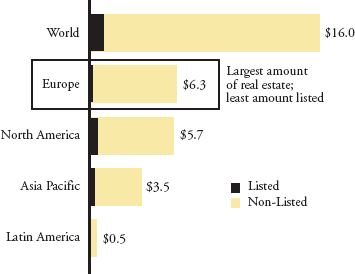| Home | About Us | Resources | Archive | Free Reports | Market Window |
|
Steve's note: Contributing today's essay is my colleague Chris Mayer. When it comes to investment recommendations, you can always depend on original, well thought out ideas from Chris. For one of his investment themes right now, read on...
The Global Rush for Bricks and Mortar Starts NowBy
Saturday, October 27, 2007
They call him the "Grave Dancer." It was a tag pinned on Sam Zell by an article in 1976 describing his exploits in buying up busted real estate projects on the cheap. The name stuck. It's a good image for Zell's style. As Hilary Rosenberg describes in The Vulture Investors, "Zell made his first fortune by tap dancing on the tombs of real estate projects... and later, he waltzed into corporate cemeteries." These days, the Grave Dancer is making more money than ever. I'm not sure what Zell's net worth is now, but I'm sure the figure starts with a "B." Therefore, when I had a chance to listen to Zell talk about investing, I took it. On a bright and warm autumn day, a flock of well-dressed and scrubbed financial types made the pilgrimage to hear the old man talk. At the New York Historical Society in Manhattan's Upper West Side, Zell took the stage in blue jeans and buttoned shirt, sans tie. Zell is 66 years old and very rich, which gets you a free pass to say and do what you want. "There is a worldwide shortage of income from bricks and mortar," Zell told us. Then he said we were in the "greatest monetization in the history of the world." What does this mean? Think of it this way: If you own an office building and go public, offering shares on your property, you have "monetized" the asset. You have realized cash and turned a physical thing into a tradable security. That tradable security is in high demand these days because people want that steady income from real estate. And the monetization of real estate is the process of meeting that demand. On a global scale, this is something that is only just beginning. Take a look at the nearby chart, which gives you a good idea of how much room this trend has.
It shows you the size of publicly traded real estate markets around the world compared with the total stock of real estate in each region. So you see that Europe has total real estate properties worth some $6.3 trillion yet has only a tiny sliver in the public markets – about 2.8%. That's because European countries only recently enacted U.S.-style real estate legislation. According to real estate firm Cohen & Steers, "In Europe, in 2007 alone, the United Kingdom, Germany and Italy enacted [such] legislation." Suddenly, sealed-off private real estate has an open door to public markets. Cohen & Steers goes on to note: "The sheer size of German private real estate holdings, for example, is extraordinary; a significant amount of these holdings could enter Germany's public real estate market by 2010." Then there is Asia. Parts of Asia, such as Japan, Singapore and Hong Kong, have had U.S.-style real estate laws in effect since 2000. So they are ahead of Europe. But the opportunity remains large. As you can see, there is still only a small sliver of real estate holdings in public hands. Privately held real estate makes up the vast majority. Zell is bullish on even North American commercial real estate. He said, "You must remember that commercial real estate is a global market. For a euro-based investor, U.S. real estate looks cheap." As the dollar tumbles, it puts U.S. assets on sale. (For a U.S.-based investor, this trend of global monetization of real estate is a great thing. The more publicly traded global real estate out there, the more ways you have to hedge yourself against a falling dollar.) Zell is no pie-in-the-sky theorist. He is active himself in Brazil, Mexico, and Asia. He owns property and businesses all over the world. He sees with his own eyes the deals still there for the taking. At the conference, he described picking up a Mexican warehouse only 100 miles from the Texas border that pays a 14% cash yield. The property was in private hands. It's now in Zell's hands. Investors want that - steady income from a tangible thing - more now than ever, as Zell pointed out. And the market will respond. Therefore, as Zell said, buy bricks and mortar - especially overseas. Sincerely, Chris Mayer
Further Reading:
Market NotesTHE AMAZING RECOVERY IN PLATINUM PRICES
In mid-2006, it looked like platinum futures registered a climax top that would take years to recover from. Platinum had climbed $325 in just five months, and most analysts expected a long recovery to digest the gains. Yet here we are in 2007, with platinum trading 12% above its old high. Platinum has two major uses: catalytic converters and jewelry. It's a pure play on three gigantic bull markets right now: The rise of precious metals as a dollar hedge, rampant environmentalism (which increases emission requirements), and Asia's mushrooming wealth (Chinese brides prefer platinum rings). The precious metal has soared 30% this year to reach an all-time high. Hence, our chart of the week. We could pick any number of commodity charts (crude oil, gold, and soybeans, come to mind) to prove our point today: In huge commodity bull markets, Jim Rogers' famous quote rings constantly in our ears: "Markets will rise higher than you think is possible and fall lower than you can possibly imagine." Right now in commodities, we're firmly in "higher than you think is possible" situation. – Brian Hunt |
Stat of the week200,000 Number of people joining the social networking website Facebook.com per day. On Thursday, Microsoft purchased a 1.6% stake in Facebook for $240 million, valuing the company at $15 billion. Recent Articles
|


